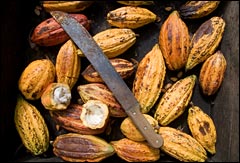Dear Umbra,
Although I buy most of my chocolate as fair trade or organic, I was wondering if you might enlighten me on the politics and economics of the chocolate (cocoa) industry. Where is most of it grown? What are the working conditions of those who are employed there? How effective is fair trade in getting to the growers?
Just another ethical choco guy
Whistler, B.C.
Dearest JAECG,
What with Halloween coming up, this is a frightfully appropriate question. Turns out the story behind the average chocolate bar is a lot scarier than ghosts and goblins.

It’s a long way from cocoa bean to Halloween.
Photos: iStockphoto
The politics and economics of the cocoa industry, as you likely won’t be surprised to learn, are stacked against the cocoa farmer and disproportionately favor cocoa traders and multinational chocolate giants.
Transfair USA, a third-party fair-trade certifier, estimates that out of the 60 cents paid for a standard candy bar in the U.S., the farmer that grew the bar’s cocoa sees about 1 cent. Most cocoa farmers in the world’s biggest cocoa-growing country — the Ivory Coast, which yields about 40 percent of the world’s crop — live in extreme poverty, often earning just $30 to $100 a year. Circumstances aren’t markedly better in the five other big cocoa-growing countries: Ghana, Indonesia, Nigeria, Brazil, and Cameroon.
This situation is exacerbated by the sometimes wildly fluctuating prices for cocoa on the world market, and by exploitative middlepeople who buy from farmers for a pittance, then make a tidy profit by selling to traders or multinationals. Without a stable, guaranteed price for their goods, most cocoa farmers are stuck in a cycle of hard work for almost no pay. Many make the difficult choice to recruit their own kids to help with the often dangerous work — think swinging a long machete when you haven’t had enough to eat, or spraying pesticides without the proper protective gear. Still others believe they have to rely on forced child labor to earn as much as possible for their crops.
In 2002, a report [PDF] by the International Institute of Tropical Agriculture and the U.S. Agency for International Development estimated that about 300,000 children work in the cocoa industry in the Ivory Coast, Ghana, Cameroon, and Nigeria. Since that report and other media investigations have come out in the last few years, the U.S. chocolate industry has acknowledged the child-labor problem. It faced pressure to work toward producing “slave-free” products by summer 2005, but that deadline passed without such a guarantee in place.

You can get your guilty pleasure with less guilt.
The fair-trade movement asserts that a way out of this far-from-sweet situation is to work with farmers and farmer cooperatives directly, prohibiting child labor and paying farmers a fair, guaranteed price for their crop (usually based on the current world market price plus a premium). With such a wage guaranteed (and inspections to make sure child-labor promises are kept), farmers’ lives can begin to improve, their kids can go to school instead of working dangerous jobs, and you, the consumer, can feel good about your delectable treat.
It’s estimated that fair-trade chocolate represents less than 1 percent of the world’s roughly $60 billion chocolate market. But the more people like you who buy it, the better things will get for cocoa farmers, we hope. So keep on looking for Fair Trade Certified or Fair Trade Federation labels.
Remember: fair trade doesn’t mean organic, and organic doesn’t mean fair trade. They are two different certifications at this point. Though if you look at your local co-op or health-food mega-store, you’ll see it isn’t difficult to find chocolate that can deliver both — and way too easy to find chocolate that offers neither.
Bittersweetly,
Umbra

